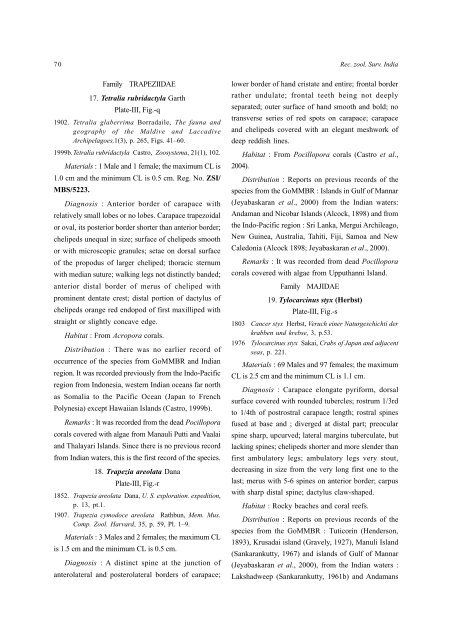Vol. 110 - Part III - Zoological Survey of India
Vol. 110 - Part III - Zoological Survey of India
Vol. 110 - Part III - Zoological Survey of India
Create successful ePaper yourself
Turn your PDF publications into a flip-book with our unique Google optimized e-Paper software.
70 Rec. zool. Surv. <strong>India</strong>FamilyTRAPEZIIDAE17. Tetralia rubridactyla GarthPlate-<strong>III</strong>, Fig.-q1902. Tetralia glaberrima Borradaile, The fauna andgeography <strong>of</strong> the Maldive and LaccadiveArchipelagoes,1(3), p. 265, Figs. 41–60.1999b.Tetralia rubridactyla Castro, Zoosystema, 21(1), 102.Materials : 1 Male and 1 female; the maximum CL is1.0 cm and the minimum CL is 0.5 cm. Reg. No. ZSI/MBS/5223.Diagnosis : Anterior border <strong>of</strong> carapace withrelatively small lobes or no lobes. Carapace trapezoidalor oval, its posterior border shorter than anterior border;chelipeds unequal in size; surface <strong>of</strong> chelipeds smoothor with microscopic granules; setae on dorsal surface<strong>of</strong> the propodus <strong>of</strong> larger cheliped; thoracic sternumwith median suture; walking legs not distinctly banded;anterior distal border <strong>of</strong> merus <strong>of</strong> cheliped withprominent dentate crest; distal portion <strong>of</strong> dactylus <strong>of</strong>chelipeds orange red endopod <strong>of</strong> first maxilliped withstraight or slightly concave edge.Habitat : From Acropora corals.Distribution : There was no earlier record <strong>of</strong>occurrence <strong>of</strong> the species from GoMMBR and <strong>India</strong>nregion. It was recorded previously from the Indo-Pacificregion from Indonesia, western <strong>India</strong>n oceans far northas Somalia to the Pacific Ocean (Japan to FrenchPolynesia) except Hawaiian Islands (Castro, 1999b).Remarks : It was recorded from the dead Pocilloporacorals covered with algae from Manauli Putti and Vaalaiand Thalayari Islands. Since there is no previous recordfrom <strong>India</strong>n waters, this is the first record <strong>of</strong> the species.18. Trapezia areolata DanaPlate-<strong>III</strong>, Fig.-r1852. Trapezia areolata Dana, U. S. exploration. expedition,p. 13, pt.1.1907. Trapezia cymodoce areolata Rathbun, Mem. Mus.Comp. Zool. Harvard, 35, p. 59, Pl. 1–9.Materials : 3 Males and 2 females; the maximum CLis 1.5 cm and the minimum CL is 0.5 cm.Diagnosis : A distinct spine at the junction <strong>of</strong>anterolateral and posterolateral borders <strong>of</strong> carapace;lower border <strong>of</strong> hand cristate and entire; frontal borderrather undulate; frontal teeth being not deeplyseparated; outer surface <strong>of</strong> hand smooth and bold; notransverse series <strong>of</strong> red spots on carapace; carapaceand chelipeds covered with an elegant meshwork <strong>of</strong>deep reddish lines.Habitat : From Pocillopora corals (Castro et al.,2004).Distribution : Reports on previous records <strong>of</strong> thespecies from the GoMMBR : Islands in Gulf <strong>of</strong> Mannar(Jeyabaskaran et al., 2000) from the <strong>India</strong>n waters:Andaman and Nicobar Islands (Alcock, 1898) and fromthe Indo-Pacific region : Sri Lanka, Mergui Archileago,New Guinea, Australia, Tahiti, Fiji, Samoa and NewCaledonia (Alcock 1898; Jeyabaskaran et al., 2000).Remarks : It was recorded from dead Pocilloporacorals covered with algae from Upputhanni Island.Family MAJIDAE19. Tylocarcinus styx (Herbst)Plate-<strong>III</strong>, Fig.-s1803 Cancer styx Herbst, Veruch einer Naturgeschichti derkrabben und krebse, 3, p.53.1976 Tylocarcinus styx Sakai, Crabs <strong>of</strong> Japan and adjacentseas, p. 221.Materials : 69 Males and 97 females; the maximumCL is 2.5 cm and the minimum CL is 1.1 cm.Diagnosis : Carapace elongate pyriform, dorsalsurface covered with rounded tubercles; rostrum 1/3rdto 1/4th <strong>of</strong> postrostral carapace length; rostral spinesfused at base and ; diverged at distal part; preocularspine sharp, upcurved; lateral margins tuberculate, butlacking spines; chelipeds shorter and more slender thanfirst ambulatory legs; ambulatory legs very stout,decreasing in size from the very long first one to thelast; merus with 5-6 spines on anterior border; carpuswith sharp distal spine; dactylus claw-shaped.Habitat : Rocky beaches and coral reefs.Distribution : Reports on previous records <strong>of</strong> thespecies from the GoMMBR : Tuticorin (Henderson,1893), Krusadai island (Gravely, 1927), Manuli Island(Sankarankutty, 1967) and islands <strong>of</strong> Gulf <strong>of</strong> Mannar(Jeyabaskaran et al., 2000), from the <strong>India</strong>n waters :Lakshadweep (Sankarankutty, 1961b) and Andamans
















